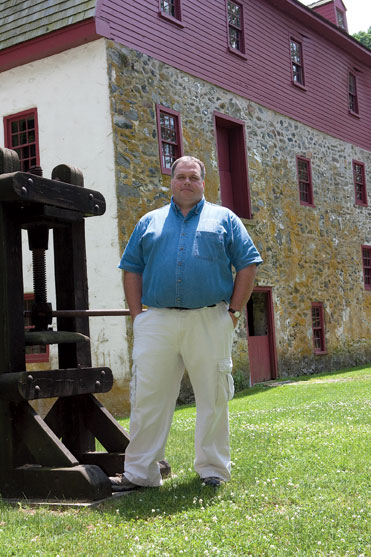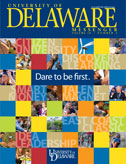Museum professional brings history to life

ALUMNI | As the 16-foot-high wooden wheel turns inside its musty stone building, powered by a rush of water from Chester Creek, the corn that was scooped into the hopper above it moves past the grinding stone and starts to pour down a chute as finely milled cornmeal.
It would be easy for onlookers to feel as if they’ve traveled back to the beginning of the 18th century and the early days of the Newlin Grist Mill near Glen Mills, Pa.
And that’s exactly what Tony Shahan has in mind as director of the 160-acre site that includes the old mill, built in 1704 and in commercial operation until 1941, and numerous other historical structures, in addition to miles of wooded trails.
“This is very much a living museum,” says Shahan, who earned his master’s degree in history and a certificate in museum studies from UD, both in 1994. He completed his undergraduate degree at the University of the Ozarks, where he gained hands-on experience in museum work and became interested in making that field his career.
“I wanted to do history, but I didn’t want to teach in a classroom,” he says. He decided on UD for graduate school after learning about its top national reputation in various aspects of professional training for careers in museums and other cultural institutions. (See article on next page.)
Shahan graduated from UD and began his career at the Greenbank Mill near Wilmington, Del., leaving in 2008 for the Newlin Grist Mill, which this year is marking its 50th anniversary as a historic site. The water-powered mill, built in 1704 by Nathaniel Newlin, is the only operating 18th-century gristmill in Pennsylvania and is on the National Register of Historic Places.
Today, the site focuses on its educational mission, as groups tour the buildings, hike the nature trails and take part in numerous demonstration activities that Shahan and his staff offer. He says the projects are designed around themes, such as the way food reflects society. Visitors might witness bread being prepared from an old recipe and then baked in Newlin’s outdoor brick oven, for example, as well as other types of authentic period cooking.
“We use food, since this was a mill for grain, as a way to connect to the public and also teach ourselves about the past,” Shahan says. “We’re doing experimental archaeology here—taking things like machinery, recipes and implements and trying to re-create the way they were used.”
In addition to the large stone building housing the water wheel and grain-milling operation, the property features a blacksmith shop, a former granary building that now is a research archive, and a house that was built by Newlin as a perk to attract a master miller to work in the business.
Interns from UD and elsewhere assist at the site, and the staff always has plenty of ideas to keep them busy, Shahan says. “We want to build a volunteer corps and eventually bring livestock back to the grounds,” he says. “We want to make the place come alive again.”
Operating a site like this is a great example of the kind of “museum work” that doesn’t take place in what people may think of as a typical museum, says Shahan, who also consults with professionals at other historic mills around the U.S. and recently was named a regional representative for the Association for Living History, Farm and Agricultural Museums. Programs at Newlin draw on science, literature, horticulture and many other fields in addition to history, he says, and every day brings something new.
For more about the site, including information about special anniversary activities planned for the first Saturday in October, visit www.newlingristmill.org.
Article by Ann Manser, AS '73





